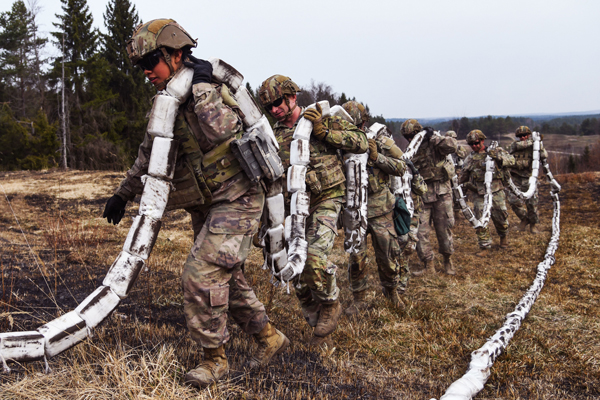 In this photo by Markus Rauchenberger, Army Lieutenant Colonel Alexander Samms, commander of the 10th Brigade Engineer Battalion, 1st Armored Brigade Combat Team, 3rd Infantry Division leads his soldiers in recovering an M69A2 Line Charge during a training exercise at the 7th Army Command’s Grafenwoehr Training Area, Germany. Unlike their Revolutionary War comrades, these soldiers have sophisticated explosive devices like these to slow an enemy’s advance.
In this photo by Markus Rauchenberger, Army Lieutenant Colonel Alexander Samms, commander of the 10th Brigade Engineer Battalion, 1st Armored Brigade Combat Team, 3rd Infantry Division leads his soldiers in recovering an M69A2 Line Charge during a training exercise at the 7th Army Command’s Grafenwoehr Training Area, Germany. Unlike their Revolutionary War comrades, these soldiers have sophisticated explosive devices like these to slow an enemy’s advance.
Ft. Leonard Wood, MO. (July 1, 2022). America’s Combat Engineers trace their history to Valley Forge and the terrible winter of 1778 under the command of General George Washington. Drawn from the ranks of artillery units, these soldier’s use of explosives often turned the tide of battle. In those days, engineers dug tunnels deep under enemy fortifications, setting off massive explosions that could then be exploited by the infantry. Today’s combat engineers perform much more sophisticated tasks using instruments the Revolutionary War soldier could scarcely imagine.
U.S. Army Combat Engineers must pass a rigorous 19-week course at Ft. Leonard Wood, Missouri while the Marines operate their own slightly shorter version at Camp Lejeune, North Carolina. Students learn basic demolitions, defusing explosive hazards, constructing obstacles, building bridges, and reconstructing ports and airfields.
Combat engineers have proven decisive in dealing with improvised explosive devices (IEDs) saving countless lives on the battlefield (The IED threat is discussed later in this newsletter). When a commander needs to emplace obstacles to slow an enemy advance or a bridge to cross a waterway under fire, they turn to America’s highly skilled combat engineers for solutions.
It takes a lot of guts to willingly take on explosive devices for a living. At SupportOurTroops.Org, we try to give these brave combat engineers “little extras” from home through our Care Package program. Won’t you take a moment to make a generous donation to this effort at our secure site SupportOurTroops.Org/donate/ Thank you!


